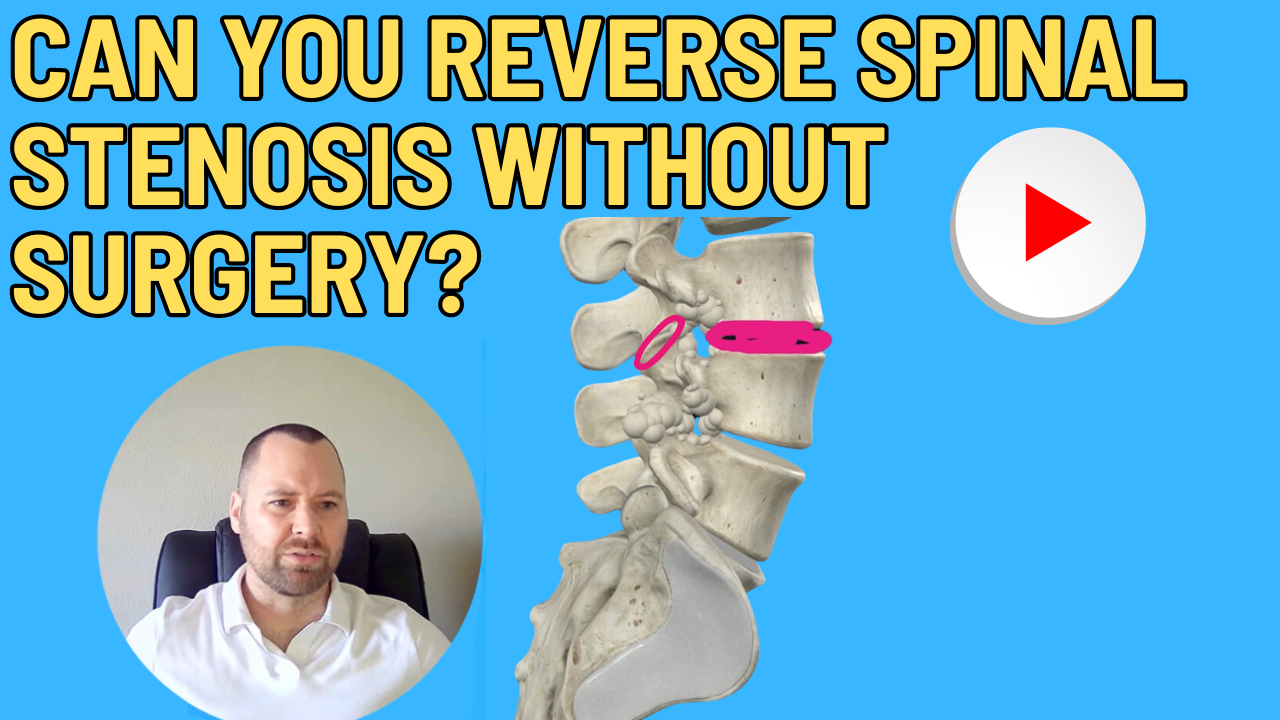
Can You Reverse Spinal Stenosis Without Surgery?
🎥 Prefer video? Watch the full video here
Can spinal stenosis be reversed without surgery? It’s a question I get asked all the time. The short answer: no, you can’t undo what’s already changed in your spine. But that doesn’t mean you’re stuck. In fact, there’s a lot you can do to feel better, move better, and keep things from getting worse.
Let’s look at the bad news first… and then the good news that gives you real hope.
What Is Degenerative Spinal Stenosis?
When we talk about degenerative spinal stenosis, we’re not talking about one single problem. It usually includes things like:
-
Osteoarthritis
-
Bone spurs
-
Degenerative disc disease
-
Spondylolisthesis (when one vertebra slips forward on the other)
-
Scoliosis
All of these can narrow the spinal canal and create irritation or pain. That’s why degenerative spinal stenosis management is about more than just one condition — it’s about addressing how all these factors affect your spine.
The Bad News
Here’s the deal: once these changes happen in your spine, there’s no exercise, stretch, or therapy that can reverse them.
-
Bone spurs won’t dissolve with stretching or adjustments.
-
Degenerated discs won’t rehydrate and “grow back.”
-
Slipped vertebrae (spondylolisthesis) won’t slide back into place.
-
Worn facet joints can’t be rebuilt by any conservative treatment.
So, if you’ve been told that a single exercise or device will “fix” your stenosis completely, that’s just not realistic.
👉 Bottom line: spinal stenosis treatment without surgery doesn’t mean reversal — it means management.
The Good News: Non-Surgical Spinal Stenosis Treatment
Now for the part you really need to hear: just because you can’t reverse spinal stenosis doesn’t mean you can’t control it.
Your spine is designed to be nicely stacked, one vertebra on top of the next. When degeneration throws off that alignment, it speeds up wear and tear. But here’s the good news: with the right training, you can improve alignment, reduce pressure, and slow that breakdown.
That means less pain, better movement, and more control over your life.
What works best?
-
Postural training to keep your spine in safer positions
-
Core stability to give your spine extra support
-
Strength training for spinal stenosis — building core and hip strength takes pressure off your spine
-
Exercises for spinal stenosis relief — targeted mobility work that helps you move without irritation
I’ve seen people with spinal stenosis reduce symptoms, avoid surgery, and stay active for years using these tools. It’s not magic — but it works.
What About Surgery?
Sometimes surgery is the right choice. But here’s something people don’t always hear: even if you need surgery, you still need strength and mobility training before and after.
If you don’t change how you move, the same breakdown can happen above and below the fused levels of your spine. That’s why movement training is non-negotiable — it’s the foundation of both spinal stenosis physical therapy and long-term spine health.
Key Takeaways
-
You can’t reverse bone spurs, disc loss, or slipped vertebrae with exercise.
-
But you can slow the process, reduce pain, and live a better life.
-
A smart plan for non-surgical spinal stenosis treatment gives you the best shot at staying active.
Next Step
Want a proven place to start?
👉 Click here to get my Free Mini Course
It teaches you four simple techniques you can use today to protect your spine and move with more confidence.
About the Author
Dr. Matt Harris, DPT, MS, is a Doctor of Physical Therapy with 18+ years of experience helping people with spinal conditions. He provides straight-to-the-point back pain solutions — from recovery to lifelong lifting. No fluff. Just spine-safe training you can trust.
Having lived through his own back injuries and guided thousands of patients, Matt knows what it takes to go from pain and setbacks back to safe, confident training.
📩 Start your own recovery journey today: Get the free mini-course here.
FAQ: Spinal Stenosis Without Surgery
Can spinal stenosis go away on its own?
No — once the structural changes are there, they don’t just disappear. But symptoms can absolutely improve with the right program.
Is exercise safe for spinal stenosis?
Yes, when done correctly. Focus on core stability, mobility, and posture to reduce strain and manage symptoms safely.
Will I eventually need surgery?
Not always. Many people manage their stenosis long-term without surgery. The goal is to use movement strategies to avoid or delay it as much as possible.
What’s the best exercise for spinal stenosis?
There’s no single “best” move. A program built around postural training, strength, and mobility works better than one exercise alone.
Why train even if I do need surgery?
Because movement is the long-term solution. Training before and after surgery helps protect your spine and prevents new breakdown above and below the surgical area.
